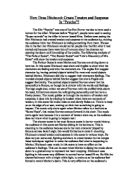How does Alfred Hitchcock create suspense and tension in psycho? Focus particularly on the 'shower scene' and 'arbogast's murder.
How does Alfred Hitchcock create suspense and tension in psycho? Focus particularly on the ‘shower scene’ and ‘arbogast’s murder.
Alfred Hitchcock 1960 horror film ´Psycho` is one of the most celebrated and scary films of its time. Hitchcock’s psychological thriller, psycho was and still is the mother of all modern day horrors. It cost Hitchcock around $800,000 to make the film. Psycho broke all film conventions by showing a leading lady having a lunch time affair in her underwear and also in the shower scene it was rejected on the grounds of nudity but was later with no alterations was accepted. The film stars Anthony Perkins as Norman Bates, Janet Leigh and Marion Crane and Vera Miles as Lila crane.
Psycho differs from other horrors because the audience starts off identifying with the main character we are shown what her life is about, her job, her boy friend and just her life in general. When Marion takes $40,000, instead of the audience disliking her because she has committed a crime they understand why she did it after all it is from a arrogant, snobby millionaire when he is talking to Marion’s boss he says ‘I never carry as much as I can afford to lose.’ So when she takes the money we don’t feel sorry for him at all. But when she is killed then we start to identify with Norman Bates. The audience is tricked in thinking that they will be following Marion thought the film but they are wrong, this is known as Maguffin of a red herring.
Hichcock uses many different devices to create tension and suspense, for example camera angle, lighting, music and red herrings all of these components make up psycho, without them the film just wouldn’t be as good or effected. One of the first examples of first person camera angles is early on in the film, where Marion is awoken by a police officer. This shot is a close up looking through the eyes of Marion. The police officers high camera angle gives a sense of superiority. Also his gaze and glasses contribute to this. Then when we are looking through the police officers eyes we look down on Marion making her look inferior the audience can see straight away how scared she is. The music and sound is also another key component of the film due to its ability to build up expectations within the audience and create a huge amount of tension and suspense. There are two different sounds in the film diegetic and non-diegetic sounds. A diegetic sound is any sound present as originated from a source within the film, it could be voices of characters or sound made from objects in the film. A non-diegetic sound is any sound coming from a course out side of the story, this could be; a narrator, a sound effect or mood music. One example of non-diegetic sound is when is when Marion is driving away whit the money she had stolen, the imagines conversations of what people would say about her leaving. The music is key to the film due to its ability to build up expectations within the audience, and create huge amounts of tension and suspense. Hitchcock had devised two different pieces of music, one being a past pace, jumpy and eerie piece which is used to build up the tension one example of this is when Marion is driving away with the money every time she starts driving the car the music starts and gets louder and louder but as soon as the car stops so does the music this might signify that every time she stops in the car she is safe but when she is driving she is driving into trouble. The second piece of music is a calm, quiet piece which is used to bring the tension down to relax the audience.







